Supermicro A3SPI-4C-LN6PF Topology
In terms of the system topology, we can see that the Atom SoC is the main hub, with a few functions going through the ASPEED AST2500 BMC. We can also see the limited PCIe and I/O lanes that are carefully used by different devices.
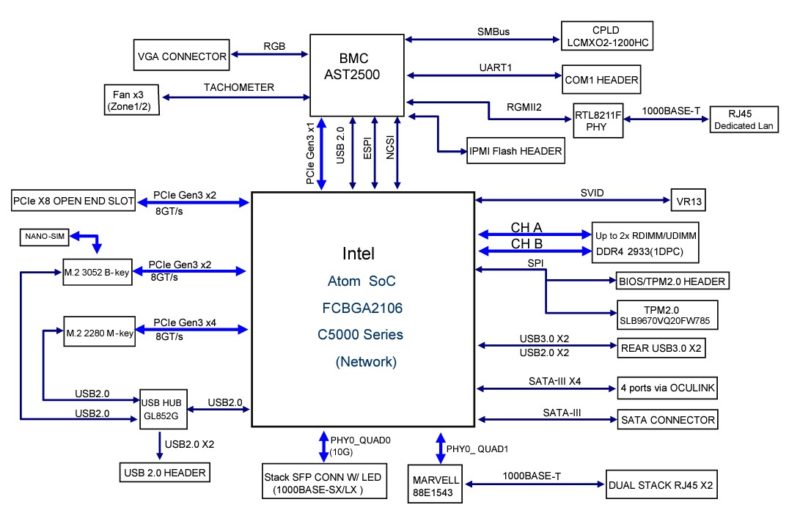
Looking at the networking quickly, the Marvell 88E1543 is being used as a 1GbE PHY. The other networking is the SFP connection listed as 1000BASE-SX/LX. This aligns with the spec page, but conflicts with the below mention of 10G SFP ports in the manual on LN6PF motherboards like this A3SPI-4C-LN6PF.

Here is the topology, and all of the NICs look the same. At this point, we were wondering if we indeed had all 1GbE ports on this NIC.
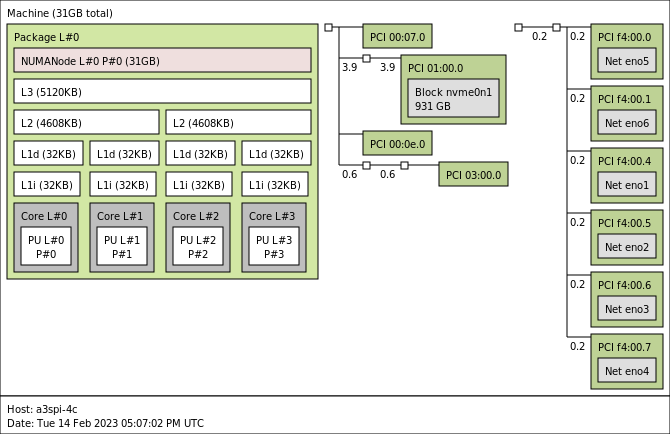
The next step was to investigate the Intel E822-L networking onboard because we saw some conflicts as to what these SFP cages were.
Intel E822-L Networking
One of the most exciting features of the new Xeon D platforms is onboard networking. Intel has moved the IP behind this networking solution from its 700 series of Ethernet controllers to the 800 series. The Intel Xeon D-1700 series we looked at recently uses the Intel E823-L, but this was the E822-L. As we installed Ubuntu, it looked like the E822-L for SFP was another 1GbE port like the four E822-L 1GbE ports.
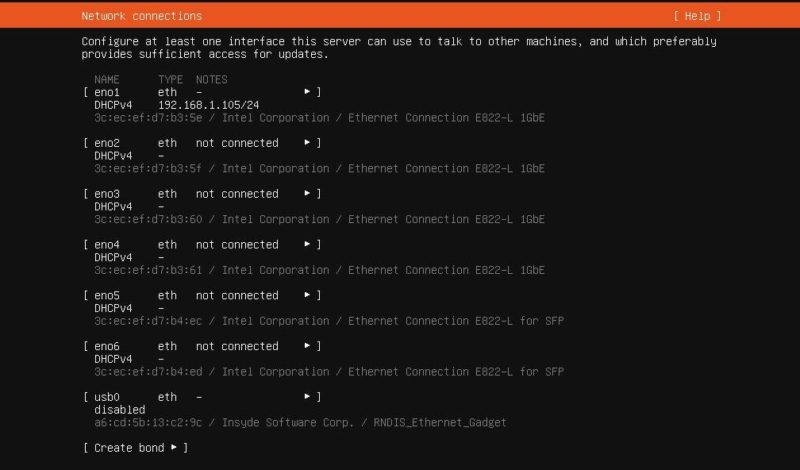
Once we installed Ubuntu, however, we saw the 1GbE ports in lshw.

We then saw in lshw that the SFP ports support 10Gbps speeds.

We connected a SFP+ DAC, and we were greeted with not just 1Gbps speeds, but also 10Gbps speeds.
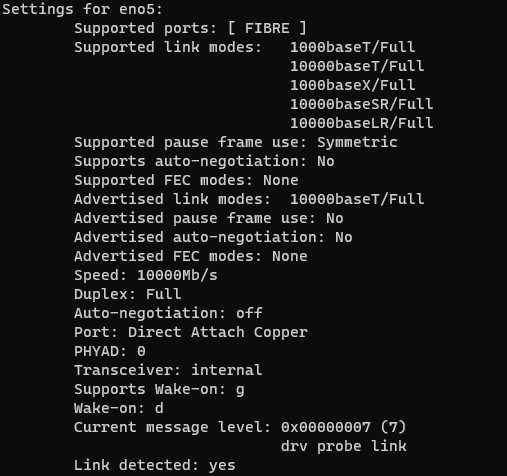
That was an awesome find. While we are using the newer Intel ice driver here, we are also getting 10GbE speeds from the SFP cages, not just 1Gbps.
Final Words
This may seem a bit controversial, but we need to start with the Intel Atom C5315. A ~129% increase in CPU cost, plus higher TDP means that while we can get more performance, we are paying for that performance. That $120 delta in chip price is just on the raw chip. It does not take into account a Supermicro margin plus the fact that as a soldered BGA chip, there are different reserves required to manage inventory and defects. The net is that the price increased about $300 due to these costs, a newer SFP platform, and inflation over something like the Supermicro A2SDI-4C-HLN4F. To many STH readers, that is going to feel like a lot.
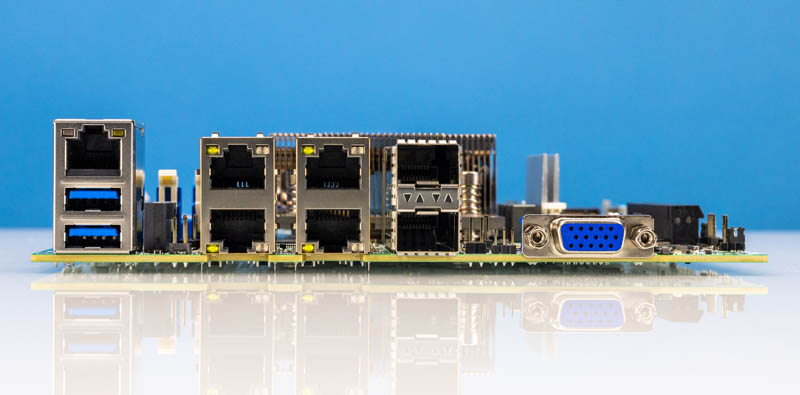
If you are looking for a 1GbE or 10GbE-class solution, and want the newer updated processor, then the Supermicro A3SPI-4C-LN6PF makes sense. We hope to get to test some of the higher core count platforms with 25GbE in the not-too-distant future since those change the value proposition integrating a higher-speed NIC. Still, the Supermicro A3SPI-4C-LN6PF went from a platform we were not excited about to one that became a lot more interesting once we tested the SFP cages for ourselves.

At the same time, this is a new retail board, so we are hoping all come with SFP+ 10Gbps performance and we are not just experiencing some early run mistake. That 10GbE with the newer 4-core Atom C5315 feels like a good match, especially for those who have seen our 2.5GbE series and want to skip to 10GbE networking instead.




That it is still being beat by the Epyc 3101, a 4 core, cpu without smt from 2018 that has a lower power consumption is less than encouraging. Unless Supermicro puts up their first born as a guarantee of the sfp+ abilities, nothing in my past experience with that company would ever bring me to think that this was anything other than a screw up on their end that will be removed either by hardware change or bios lock/neglect.
I’ve been waiting for an updated variant of A2SDI-H-TF for 6 years now. Cheap (~500€), low power (25W), 12sata, 10gbit board and I fear this still wont be it. I won’t be cheap, nor is it low power, and with reduced lanes probably not gonna have a 12sata or its gonna be even higher priced and power hungry model.
@Dami you are essentially right.
Higher TDP, basically 1 NVMe and 1 Sata port (where are all the other lines used for storage went?), and a not-so-exiting networking part.
And benchmarks on all but SSL are basically worse than a C2758, the C2000-era flagship.
I see no real use case for a box like this.
Assuming that the SFP cages are in fact 10GbE this one looks like a competent implementation of the SoC it has to work with(though I’m a little surprised that they allocated 4x lanes to the m.2 and left the PCIe slot with only 2, given that network appliance scenarios don’t tend to lean desperately hard on local storage; and you’d need to be running a pretty decent SSD and a pretty heavy OS for 2-lane NVMe to make boot times or logging unacceptably slow); I’m just wondering what Intel thinks they are playing at.
$120 more than the prior gen part, plus substantially more power hungry; plus less PCIe; for what appear to be pretty marginal generational improvements?
I can understand the premium that network-included Atoms carry vs. the ones that show up in very low end client systems and cheap ‘n cheerful pfsense boxes; even if you don’t care about ECC you won’t actually save much if need to add anything faster than 1-2.5GbE as discrete parts; but $120 is the premium vs. the last gen version of the more or less identically placed part.
I can’t tell if Intel is surprisingly unconcerned by ARM network oriented processors; or if they are really concerned and figure that they might as well extract what they can on the way out of this niche. Over in Xeon-D land there’s still a pretty solid per-thread performance case to be made; but a 4 core fairly high TDP Atom part isn’t in Xeon-D land.
This is a surprisingly weak improvement for near 6 years.
I was looking for a reasonable amount more at the same tdp or of course, significantly more at a higher one.
I do wish AMD would compete in this space , including the platform and board variety, not just processor performance.
After the Intel Avoton fiasco, there’s no way I’m considering the stuff when there are other options.
We were looking forward to this platform but the underwhelming CPU upgrade from the C3000 series and disappointingly large price increase has us looking elsewhere.
Any throughput testing, even just a basic iperf, to see if those 10GbE rates are the real thing, and not just a configuration hiccup somewhere? The thing is certainly confused enough about itself, I wouldn’t be surprised by anything at this point.
The SoC is trimmed down Snow Ridge, which is not very fresh but still very interesting for a number of use cases. These SKUs are a bit old but good if priced correctly (room for 2/3 NVMe SSDs, up to 12 SATA ports, QAT, 10Gbit networking), what really sucks here is Supermicro: they have never managed to get the Atom line right, with the correct offering and ports. Can you explain to me why you must loose 2 PCIe lanes for a B-key M.2 slot on a system with 20Gbit ethernet? WHY? Why a 2 lanes PCIe expansion slot? This way they are both useless! Do you want a small scale NVMe NAS? You can’t now with a C5315. Do you want more than 5 Sata ports? You can’t although the SoC supports them! It’s nonsense, why is Supermicro run by this guys? They try to satisfy multiple scenarios with one product failing badly for all of them.
@Safari
“Can you explain to me why you must loose 2 PCIe lanes for a B-key M.2 slot on a system with 20Gbit ethernet?”
This was actually the reason I bought this board (A3SPI-8C-LN6PF), because you can use it for a 5G cellular modem as a backup link (hence the SIM card slot).
At least that was my intention. Apparently there is a bug in the firmware that does not detect a PCIe cellular modem in the M.2 slot. This issue has been open for 2 months and has been escalated to Intel with no fix or workaround available yet.
@elk Because buying this board/SoC for such a purpose makes no sense. It does makes sense to use it for storage, but you must not waste the few precious PCIe lanes with nonsense slots.